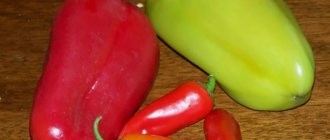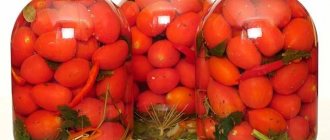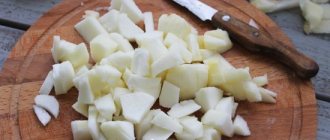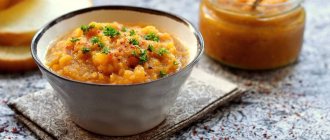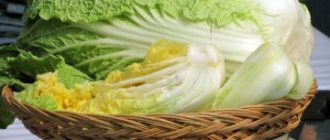Simple and delicious soups for every day
Today we will look at how to prepare simple and tasty soups for every day, we will provide recipes with photos. No, we will not prepare all kinds of delights with many ingredients, our task is to teach how to cook simple and easy soups for everyday use, tasty, healthy and quick to prepare. Some soups can be a light snack, a medicinal addition to the diet, or a rich, thick dish that will immediately replace both the first and the second, and will satiate the whole family. Look at delicious soup recipes with photos.
Pea soup with croutons
A hearty, light and aromatic soup that we recommend making for your family’s lunch. The base is the simplest - peas (it’s better to take them in halves, it will cook faster), croutons, potatoes, onions and herbs. For a more complex option, you can add a piece of smoked chicken, fried onions, carrots, tomatoes, a set of spices, and so on. But - we will now deal with the simplest and most delicious option.
For a family of three we will need:
- Half a cup of peas
- 3 potatoes
- 1 onion
- A pack of croutons (you can dry the croutons yourself in the oven)
- Greenery
- A couple of tablespoons of oil
- You can add carrots
- Water – 3 liters
Preparation:
Boil the peas. This is the longest process in preparing this soup, so it is best to soak it in the morning. And before lunch, rinse and set to cook. In the meantime, you can cook croutons or run to the store for a pack. You can take it with a spicy taste, it’s an extra pleasant note to the soup. Once the peas are ready, add finely chopped potatoes, salt, and maybe pepper if the kids won’t eat them.
Fry a finely chopped onion in oil (if you took a carrot, grate it finely and fry it too), add half a spoon of flour, fry a little more and send it to the peas. Chop the greens finely and let them sit in a plate for now.
As soon as the potatoes become soft, turn off the soup and let it brew for at least 10 minutes - it will become more appetizing and more aromatic, and richer in taste. Next, pour the soup into bowls, throw in a pinch of herbs, put croutons in a plate next to it, and you can eat it - delicious! And on the second, look at recipes for delicious dishes with photos.
Lentil soup
Such a light and satisfying soup at the same time is prepared like a pea soup. But - if you take green lentils, then you need to throw them right away with the potatoes, because they cook quickly. To replace the second one at once, take more lentils, add fried vegetables, herbs and get a thick, satisfying soup. It will take little time to prepare, but the result is excellent.
We will need:
- For three liters of water, a glass of lentils;
- 3 potatoes;
- Bulb;
- Carrot;
- Spoon of tomato;
- Greenery;
- Garlic - a couple of cloves.
Cooking;
Rinse the lentils, add water, and cook. Peel the potatoes, cut them into small pieces - send them there, make friends with the lentils. Making the frying - chop the onion, carrots and garlic as you like. Fry all this beauty in a frying pan with oil, adding the garlic last, before adding the tomato. When the frying is ready, add it to the soup and let it simmer. In the meantime, season it with salt, add pepper and spices if desired, and chop the herbs. When the lentils become soft, the soup is ready. Toss the greens and turn it off. Let it brew for a while and pour into plates. You can add sour cream, half a circle of lemon - depending on your taste. Bon appetit!
Soup in a slow cooker
The simplest thing is to prepare rice soup using a multicooker - dietary, light, and at the same time satisfying, both children and older people can eat it, in general, everyone will like it.
Products:
- Chicken breast
- 0.5 cups washed rice
- One carrot and one onion each
- 3 potatoes
- Salt, herbs, oil
Pour oil into the bowl of your multicooker, throw in finely chopped onions and carrots. Turn on the "Baking" mode. While the vegetables are frying, with your attention and stirring, cut the breast, greens, and potatoes into cubes. Once the vegetables are fried, switch to the “stew” mode, throw the chicken meat and potatoes into the bowl, add spices and salt, and let it cook for an hour under the lid. As time passes, the soup is ready, pour it into a plate, add a pinch of greens to each plate - a delicious soup in a slow cooker is ready to eat!
You can add satiety to your lunch with the recipe for basic Tatar with pickles.
Meatball soup
Light, dietary, very tasty and aromatic - you can easily feed your kids this soup, and your husband will rejoice at such a tasty dish. Moreover, it is simple and easy to prepare. So, the products:
- 300 g minced meat;
- 1 egg;
- A little greenery;
- One onion and one carrot each;
- 2 potatoes;
- favorite spices, salt.
How to cook:
The very first thing is to put water in a saucepan on the fire. By the time it boils, we will have everything ready for cooking the soup.
Mix the minced meat with the egg, chopped herbs, salt and grated onion. Form into round balls. By this time, your water should already be boiling - add salt to it, and carefully throw the meatballs in there one by one. Add finely chopped potatoes and let them cook.
In a frying pan, adding oil, fry finely chopped onions and carrots, you can add half a spoonful of flour for thickness, you can leave the broth clear. Now add everything to the soup, taste it - maybe add some salt. Turn off and pour into plates. Add greens - the soup is tasty and aromatic, easy to prepare, ready!
Say thanks for the article 0
RECIPES: Homemade instant soup
Using the recipe for preparing the ingredients from this recipe as a basis, you can prepare absolutely any soup, but we will focus on the classic miso with chicken and mushrooms.
The main thing in this recipe is airtight packaging, which will allow you to deliver all the packaged ingredients safe and sound. A jar with a tight-fitting lid or a glass food container that can withstand high temperatures would be ideal.
Place all the spices at the bottom of the jar, in our case this is dashi broth, miso, a slice of ginger, chili flakes, dried garlic and a little soy sauce. If you're making regular chicken or vegetable noodle soup, add your favorite dried herbs, vegetables, and salt and pepper.
The next layer is the selected additives: frozen, pickled or fresh vegetables, mushrooms, boiled meat, fish. Preference should be given to those ingredients that can be eaten raw or blanched, which is why, instead of the usual shiitake miso soups, we chose champignons that do not require pre-soaking and can be quickly cooked in boiling water.
Please note that the ingredients should be cut as thin as possible or grated.
The final layer is noodles. Regular thin rice noodles and the main ingredient in store-bought soups, ramen noodles, are simply cooked by boiling water. It is better to pre-boil any other noodles, sprinkle with oil and place them on top of the vegetables already prepared. The quantity is at your discretion.
You can also take a clean ziplock bag, pack the chopped greens into it and place it directly into the jar.
By closing the lid, you can leave the soup base in the refrigerator overnight if you decide to prepare lunch for work or school in the evening.
By the beginning of lunch, all that remains is to boil water in the kettle and pour it into the contents of the jar. Leave rice noodles and ramen to steam for 2-3 minutes, and pre-boiled noodles can be eaten immediately.
Ingredients (per 500 ml jar):
- 45 g rice noodles;
- 20 g mushrooms;
- 50 g chicken;
- 1 tablespoon miso paste;
- 1 tablespoon soy sauce;
- ½ teaspoon dashi broth;
- ½ teaspoon dried garlic;
- a pinch of chili flakes;
- a slice of ginger.
Preparation
- Place miso at the bottom of the jar, pour in soy sauce, add dashi broth, dried garlic, chili and ginger.
- Separate pre-boiled chicken into fibers and distribute in a jar along with thin slices of fresh peeled mushrooms.
- The final layer is rice noodles, which are placed in the jar raw.
- Before use, pour boiling water into the jar, leave the soup for 2-3 minutes, stir and taste.
Hot soups
Cold soups are prepared without simultaneous cooking of the components, while hot soups are prepared with it. Boiled liquid dishes are very appetizing, nutritious, and give you a feeling of fullness for a long time. Hot soups are varied: thin and light, with light vegetables - good for breakfasts, dinners, and used in therapeutic nutrition. Rich, fatty, with a thick side dish of pasta, legumes, potatoes, with the addition of meat, fish, chicken fillet - satisfying, they will replace a full lunch.
In most cases, the cooking process does not take very long. However, such a dish can be unusual; it can be a pleasant surprise for your holiday guests.
Literature[ | ]
- Pokhlebkin V.V.
Soups // Culinary Dictionary. - M.: E, 2020. - P. 343-344. — 456 p. - Pokhlebkin V.V.
Soups // Secrets of good cuisine. - M.: Young Guard, 1985. - P. 102-123. — 191 p. - Kovalev N.I., Usov V.V.
What are the benefits of soup // Stories about the secrets of home cooking. - M.: Chemistry, 1993. - P. 210-229. — 336 p. - Usov V.V., Usova L.A.
Soups // Basics of culinary skills. - M.: Eksmo, 2020. - P. 214-300. — 384 p. - Ratushny A. S.
Transparent soups // Everything about food from A to Z: Encyclopedia. - M.: Publishing and trading corporation "Dashkov and Co", 2020. - P. 287. - 440 p. — 300 copies. — ISBN 978-5-394-02484-9. - Ratushny A. S.
Refueling soups // All about food from A to Z: Encyclopedia. - M.: Publishing and trading corporation "Dashkov and K°", 2020. - P. 379-380. — 440 s. — 300 copies. — ISBN 978-5-394-02484-9.
Simple noodle soup
The simplest soup recipe, indispensable for those who want to learn how to cook soup quickly.
To prepare the dish we will need:
- vermicelli, 100 g
- carrots, 1 pc.
- garlic, 3 cloves
- vegetable oil, 4 tablespoons
- potatoes, 1 pc.
- a bunch of green onions,
- bunch of parsley
- black pepper to taste
- salt to taste
- Boil 1.5-2 liters of water.
- Peel carrots and potatoes, finely chop
- Peel and chop the onion and garlic
- Fry garlic and onion in a frying pan
- Add potatoes and carrots to them
- Continue frying for 3 minutes, then pour into the pan
- Boil for 5 minutes and add vermicelli
- Boil for another 7 minutes
- Chop the greens and add them to the soup.
- Add salt and pepper to taste
- Give the soup time to brew, 2-3 minutes will be enough.
Preparing hot soups
Regardless of what type of hot soup it was decided to prepare, the work of creating it at the forge will necessarily go through the following stages:
- If broth is the basis for the dish, then it must be boiled until fully cooked. If just water is used, then it is boiled.
- Next, add the soup ingredients to the boiling liquid. Moreover, the ones that take the longest to cook are put in first, the fastest-cooking ones are added at the end.
- At the end of cooking, the dish is seasoned - salt, spices, and herbs are used to taste. 10 minutes after adding them, turn off the fire.
Cooking soup correctly
Most often, soups are cooked in broths (meat, fish, mushroom, bone-meat, vegetable), as well as in milk, kvass, and fruit decoctions.
The taste of the soup directly depends on the quality of the prepared broth. If you are making bone broth, you will need to chop the bones first. And when using pork or veal bones, it is better to fry them in the oven before cooking the broth. Then the taste and color of the broth will be more saturated.
Ingredients must be added to the soup in a certain sequence. The foods that take the longest to cook are cooked first. Vegetables are also added in order. The onions are put in first. It is usually fried a little, then sautéed carrots, celery or parsley are added.
Vegetables also need to be cut correctly. For example, if the soup is with pasta, then the potatoes need to be cut into cubes, if with cereals - into small cubes. This is done not only for an aesthetic purpose, but also for a practical one - the difference in the cooking time of products is reduced.
If the soup contains pickled or pickled products, they should be added after the potatoes are cooked. The thing is that potatoes do not boil well in sour broth.
Pasta soup should be cooked in a small container, because such a product cannot be stored for a long time. When the dish cools, it loses its taste and beneficial qualities.
Spices (usually allspice, bay leaves, cloves, black peppercorns) are added a few minutes before cooking, then the taste and aroma of the soup will be more intense.
History[ | ]
Soup, as a dish in its current understanding, emerged no more than 400-500 years ago, with the advent of strong, non-oxidizing and chemically neutral utensils that made it possible to carry out the cooking process. It should be noted that in the East (Ancient China and nearby regions) soups arose earlier, about 100 years BC and, again, in connection with the earlier appearance of suitable utensils. This does not mean that people did not previously use cooking - this method of cooking arose with the advent of clay and stone utensils. However, it is necessary to distinguish soup as a dish, where its components are inseparable parts that create a common taste, overall composition, and simply boiled products or a mixture of them, where cooking served only the purpose of heat treatment of the product. The resulting decoction, at least in primitive times, was not used. [ source not specified 144 days
]
With the advent of dishes, familiarity with earthenware and porcelain and cutlery, soup began to spread first in Southern Europe in the 16th centuries, and became widespread only in the 17th-18th centuries [ source not specified 137 days
]. Of course, cooking methods and soup recipes were developed earlier.
In addition, soup is historically a dish of a sedentary person; nomadic peoples did not know soups, or they were extremely uncommon and were prepared on special occasions [ source not specified 144 days
].
An example of this is Kazakh cuisine: until relatively recently (before the borrowing of shurpa from the Uzbeks) there were no soups in this cuisine [ source not specified 144 days
]. If you really want to, thickened soups can include dishes such as beshbarmak and nauryz-kozhe, but they are still not soups in their pure form, and besides, especially the latter, they were festive.
Today there are approximately 150 types of soups in the world, which are divided into more than a thousand types, and each type can have several variants. So V.V. Pokhlebkin points to 24 variants of cabbage soup, 18 variants of fish soup. However, only the types of soups have striking differences from each other.
In Russian, the word “soup” has been fixed since the beginning of the 18th century and came from Western European languages - Dutch ( soep
), German (
suppe
) or French (
soure
), dating back to Late Lat. suppa with the possible meaning of “a piece of bread dipped in gravy”, or associated with the meaning of “flavor with spices”[4][5][6].
The word soup
appeared only in the era of Peter I; before that, liquid dishes of Russian cuisine were called stews.
At first, soup meant only foreign liquid dishes, but later the name was extended to national stews. Written monuments of the 16th-17th centuries divide soups into cabbage soup, kalya (rassolnik), fish soup, selyanka (solyanka), borscht and stew. [ source not specified 144 days
]
Types of soups
Soups are divided into types according to some characteristic. So, based on the supply temperature, they distinguish:
- hot soups
. These include rassolnik, solyanka, borscht, etc. They are served at a temperature of 60-70 degrees. - Cold soups
are not heated before serving. They are prepared on the basis of dairy and fermented milk products, with or without meat, and with vegetables. The serving temperature is usually from 6 to 12 degrees.
Interestingly, soups such as fish soup and gazpacho can be consumed both cold and hot.
According to cooking technology, all soups are divided into:
- transparent.
These include broth, stew, fish soup, etc. From the name it is clear that in this type of soup a clear broth (from poultry, fish, meat) is required. As a rule, such soups are also served with a side dish (rice, meatballs, noodles, pasta, etc.). Moreover, the side dish should be prepared separately from the broth, and before serving it can be added to the soup. - gas stations.
These include rassolnik, solyanka, borscht, etc. Seasoning soups are prepared using any broth, even vegetable broths. When cooking, they add cereals, pasta, vegetables, etc. - Thickened soups
are thickened with some component during the cooking process. Most often it is flour. But in addition to it, eggs, fermented milk products, as well as egg-sour dressing can be used as a thickener. - puree soups
(for example, gazpacho). The peculiarity of this type of soup is that all components are crushed (for example, in a blender). They are cooked in meat broths, milk, with the addition of vegetables, cereals, and legumes. Such soups are very delicate in taste, easy to digest, and therefore are often recommended for children and the elderly. - Stir-fry soups
are soups in which the ingredients are first fried and then added to the liquid. - combined soups.
This type is most typical for Far Eastern cuisine. Their peculiarity is that all components are added to the decoction or broth immediately before taking it. - sweet.
These include milk soups, as well as fruit ones. As a rule, such soups are served as dessert.
Milk soup with vegetables
Ingredients
- 1 liter of milk
- 400 g water
- 400 g potatoes
- 400 g cauliflower
- 100 g carrots
- 300 g green peas
- 20 g butter
- salt to taste
Preparation
- Cut the carrots into small cubes, sauté in half the amount of oil until they color.
- Separate the cabbage into individual florets.
- Cut the peeled potatoes into small cubes.
- Boil milk, skim off foam.
- Bring the water to a boil, add salt, add potatoes and cabbage, after boiling, add sautéed carrots.
- Cook over low heat until half cooked, then add hot milk and bring the soup to readiness.
- At the end, add green peas, let it boil and brew for 15 minutes.
- Place a piece of butter on top of the bowl of soup. Bon appetit!
Soup recipes are varied, so you can try a new option every time. Warm soups are especially good in frosty winter. Use these recipes and tasty and healthy soups will warm your family during the cold season!
Source


